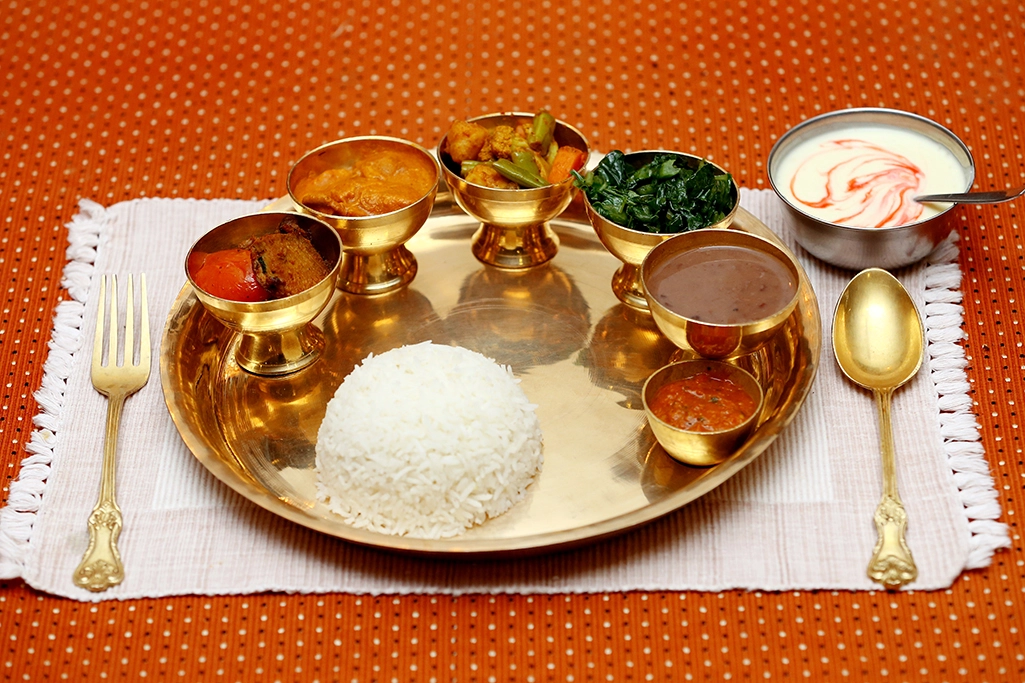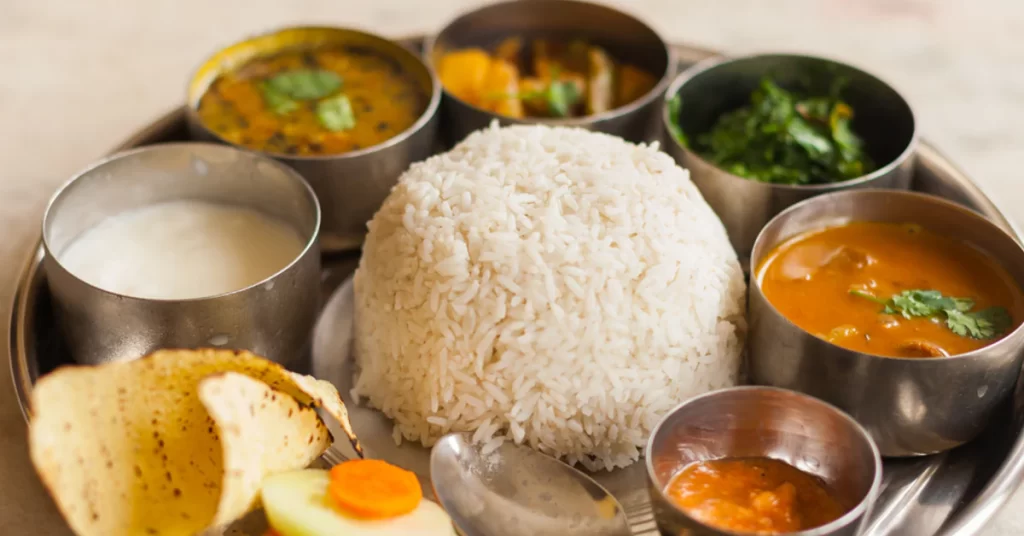Dal Bhat is one of the most defining elements of Nepalese cuisine. But it is more than just a simple meal. It is a way of life, culture, and foundation in Nepal. Dal, lentil soup, and Bhat, rice, are the heart of the dish and come with several side dishes, such as vegetables and pickles, and sometimes fish or meat. This simple dish is distinguished by its nutritious value and basics – it fuels millions every day in Kathmandu streets and Himalayan mountains. The following research will discuss the cultural aspects and nutritional value of the dish, as well as its variations.
Table of Contents
ToggleThe Cultural Significance of Dal Bhat
A Staple Across Nepal
Dal Bhat is an essential Nepalese meal that is loved by the people. Consumed by the masses twice a day, it is “Dal Bhat power, 24-hour”. This statement is funnier than others as it demonstrates the resilience of this dish. The observation of this meal pattern signifies that love is deeper in the Nepalese lifestyle than in any dish.
Symbolic and Social Importance
Dal Bhat is more than just nourishment; it symbolizes hospitality and community in Nepal. Serving Dal Bhat to guests is considered a sign of respect and affection. During festivals and celebrations, variations of Dal Bhat are prepared with special ingredients, signifying its integral role in social and religious occasions.

Nutritional Profile of Dal Bhat
Balanced Diet
Moreover, Reddy and Kunwar noted that the dish is not only tasty but also well-balanced food. The protein in dal supplemented by rice forms a complete protein, which is vital in the diet of a mainly vegetarian population . Lentils give fiber, iron, and protein and rice a major source of carbohydrates.
Health Benefits
Regular consumption of Dal Bhat can contribute to a healthy diet due to its high fiber content, which aids in digestion and prolonged energy release. The typical side dishes of vegetables add vitamins and minerals, making Dal Bhat a wholesome meal that supports overall health.
Preparing and Serving Dal Bhat
Essential Components
The basic components of Dal Bhat are:
- Dal: The lentil soup is prepared by simmering lentils with turmeric, salt, and a tempering (tarka) of fried onions, garlic, and sometimes tomatoes.
- Bhat: White rice is the most common, but brown rice is occasionally used for its nutritional benefits.
Traditional Accompaniments
A traditional Dal Bhat meal is served with a variety of side dishes:
- Tarkari (vegetable curry): A mix of seasonal vegetables cooked with Nepalese spices.
- Saag (green leafy vegetables): Spinach or mustard greens sautéed with garlic and cumin.
- Achar (pickle): Spicy and tangy, made from fruits or vegetables.
- Meat or fish: For non-vegetarians, pieces of chicken, goat, or fish curries are common.
Presentation and Etiquette
Dal Bhat is usually served in a thali: a large metal serving dish that has small bowls around the rim for the dals, and the rice is served in the center. The customer then eats it using his or her right hand; he or she uses the fingertips to mix the rice with dal and curries . However, in urban regions or when going out for food, people use cutlery.
Regional Variations of Dal Bhat
Territorial Differences
Being prepared and eated throughout the country, Dal Bhat’s ingredients and accompaniments are notably diverse from region to region, ultimately due to climatic factors and local produce. The Terai features more fresh vegetables and a wider array of pickles, while the mountainous regions are famous for their preserved vegetables, and lean heavily on potatoes and yak meat.
Adaptations Beyond Nepal
As Nepalese communities have established themselves around the world, Dal Bhat has found a place in the global culinary scene. Restaurants often adapt the dish to cater to local tastes and ingredient availability, incorporating elements like local greens or beans, but always maintaining the heart of the dish.
The Global Appeal of Dal Bhat
Promoting Nepalese Culture Worldwide
Dal Bhat, in this way , acts as a gastronomic representative of Nepal, assisting in the discovery of Nepalese tastes and customs for people all over the world. In every major city in the UK, from London to Los Angeles, there is a thriving Nepalese eatery scene which serves Dal Bhat as their most classic gourmet edifice, along with the stories of national traits that assist patrons in better understanding their sides. It is our conviction that these organization serve as an ambassador for Nepalese cuisine, demonstrating that there is much more to it than popular Himalayan expeditions.
Fusion and Innovation
Culinary experts always strive to mix and match popular dishes from one country with the flavors of others to produce a perfect and delicious dish that is acceptable to almost everyone. In this regard, these chefs can use the already developed recipe of Dal Bhat to combine with other traditional ingredients and flavors of other countries to make new varieties of the dish. For instance, in some parts of the world like the United States, the consumers are opting for products that are made up of organic foods.
Educational Initiatives and Dal Bhat
Culinary Schools and Cooking Classes
With curiosity around cuisines from around the world has increased, many international culinary schools have introduced courses on Dal Bhat and others. These courses provide a detailed study of various spices, methods of cooking different South Asian dishes, and the various meal types. Other than that, certain cooking classes only focus on Nepalese cuisine may provide food lovers with the opportunity to learn from experienced chefs who delve into the flavors and meaning of meals such as Dal Bhat.
Online Platforms and Food Blogs
The spread of food blogging and online culinary platforms has also contributed to the popularity of Dal Bhat. Online publications by food bloggers with recipes, cooking advice, and reviews of Dal Bhat cooking methods make the dish available to people around the world. Moreover, food podcasts and video blogs foster a community of people who are knowledgeable about and supportive of the nuances of hometogel.

Nutritional Research and Dietary Relevance
Academic Studies
According to recent nutritional studies, traditional diets such as the Nepalese diet centered around Dal Bhat have several health benefits . As previously mentioned, Dal Bhat ‘s macronutrient composition ensures a sustainable energy release, well-suited for high-energy activities: another factor that explains why it is a staple of trekkers in the Himalayas. These studies have a positive effect on health awareness, promoting the idea of regularly consuming a mixture of whole grains, lentils, and vegetables.
Dietary Inclusion
Moreover, Dal Bhat is also part of a recommended meal bundle for deal dieticians and health professionals due to it being an incorporation of complex carbohydrates, proteins, and essential vitamins from its plant-based synthetic. The possibility of combining multiple vegetables and protein without unhealthy fats further makes this a meal for weight and diabetic practitioners.
Cultural Festivals Featuring Dal Bhat
Celebrations and Food Fairs
Dal Bhat is often a star feature of many Nepalese cultural festivals and food fairs, recognized as but not limited to afull meal and an expression of the culinary and cultural life of Nepal. Aside from that, these festivals typically are accompanied by live cooking of the meal, performances of the culinary culture of other nations, and, of course, competitors who offer their versions of Dal Bhat.
Community Gatherings
In many Nepalese communities, preparing and sharing Dal Bhat is a communal activity that strengthens bonds among family and friends. Community gatherings, especially those in the diaspora, often feature large communal pots of Dal Bhat, reinforcing cultural identity and connecting people through the shared experience of traditional Nepalese dining.
Celebrating the Essence of Nepalese Cuisine
In conclusion, the humble and culturally rooted Dal Bhat continues to be a main pillar of Nepalese cuisine at home and around the world. Even as it morphs into new palettes and table settings, Dal Bhat manages to stay true to the recipe and provides the same nourishing and comfort-enhancing qualities. At the traditional place or country, Luchai or on the country, high-class restaurant offerings Dal Bhat continue to be one of the hallmark symbols of Nepalese food and entertainment, a dish that everyone on the planet is encouraged to enjoy.
Not just the meal, Dal Bhat is a testament of resourcefulness and resilience of the Nepalese people. Its simplicity, nutritional value and adaptability across cuisines make Dal Bhat a recognizable dish across culture, an opportunity to explore the country’s cuisine. Home kitchen of a Nepali village household or on the luxurious offering of an international boutique restaurant, Dal Bhat nourishes and comforts its lovers, the timeless meal of Nepalese cuisine.
Also read: Tunnel Vision: Its Impact and Overcoming Limitations 2024



